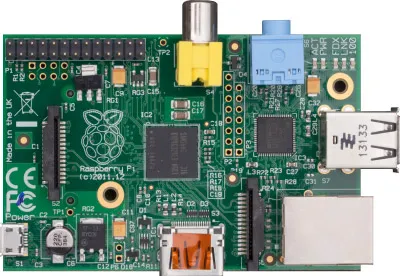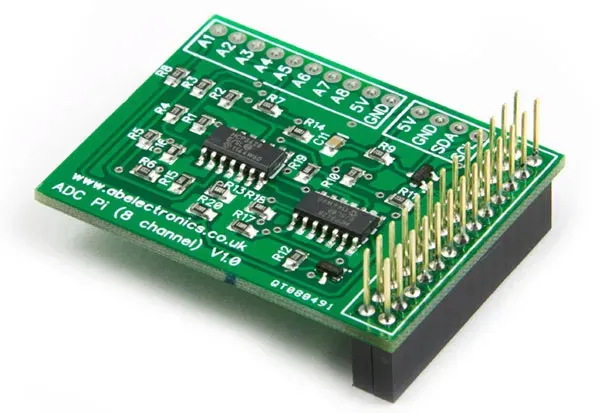Celebrating 12 Years of AB Electronics UK
As we celebrate our 12th anniversary in August 2024, we reflect on our journey, the challenges we've overcome, and the milestones we've achieved along the way.
The Raspberry Pi

In February 2012, the first affordable Raspberry Pi model was released, transforming the world of computing by making it accessible to hobbyists, educators, and professionals.
The Raspberry Pi Model B boasted a 700 MHz ARM11 processor, 256 MB of RAM, and various ports, including HDMI, USB, and Ethernet. Additionally, it featured a GPIO (General Purpose Input/Output) header, enabling users to connect a variety of sensors and devices, making it perfect for a wide range of projects.
The Raspberry Pi was designed with affordability in mind, making it a game-changer in the world of computing. When the first model was released in 2012, it was priced at around £22 ($35), making it accessible to a wide audience, including students, hobbyists, and educators. This low cost opened up new opportunities for learning and experimentation, allowing users to undertake projects that would have been prohibitively expensive with traditional computers. Over the years, subsequent models have varied in price, but the Raspberry Pi Foundation has consistently aimed to keep the devices affordable, ensuring that anyone with an interest in computing can access this powerful and versatile tool.
There was one issue with the Raspberry Pi however in that the Raspberry Pi’s GPIO header supported only digital communication, unlike the popular Arduino boards, which included analogue inputs for measuring voltages.
Making Development Boards
In 2012 we built a simple analogue input board for the new Raspberry Pi to use with our home solar logging system. After posting an article on our blog about the new analogue board we began to receive a lot of enquiries asking for a commercial version other people could purchase to use on their own Raspberry Pi’s.

After doing some researching into manufacturing electronics we designed a small PCB to fit onto the Raspberry Pi GPIO header and ordered the components to build the boards. We also started work on a new e-commerce website to sell the boards online.
The first 100 ADC Pi PCB’s arrived in September 2012 and after hand placing all the components we launched our new e-commerce website AB Electronics UK. The first batch of 100 boards sold out faster than expected and in November 2012, following feedback on the initial design, we redesigned the PCB and upgraded the ADC chips to use the MCP3424 ADC chip from Microchip which is an 18-bit ADC improving the resolution from the original design.
We also started to work on an IO expander to add more GPIO pins to the Raspberry Pi which evolved into the IO Pi Plus with 32 GPIO channels and a design that can be stacked up to four boards high giving up to 128 additional input and output channels.
Since 2012 the initial two products have evolved into over 40 development boards and accessories for the Raspberry Pi and compatible computer boards which we sell today.
Making our Development Boards stackable and different to others available
Many other businesses have released Raspberry Pi Hats and development boards but nearly all are designed to only allow one board to be used at a time on your Raspberry Pi. We wanted our boards to be stackable and allow you to mix the boards used at the same time and after a lot of research we found a source of a 40 pin header connector with longer pins allowing it to be stacked with spacers between each board.
The Development Boards and changes to the Raspberry Pi HAT format
Over the years, we've expanded the product line-up to include a wide range of accessories, each designed to meet the evolving needs of our customers. Some of our most popular products include:
-
ADC Pi: An analogue-to-digital converter board that allows Raspberry Pi to interface with analogue sensors.
-
IO Pi Plus: A digital IO expander with 32 inputs and outputs which could be stacked to add up to 128 IO channels.
-
RTC Pi: A real-time clock module that ensures accurate timekeeping, even when the Raspberry Pi is powered off.
-
Servo PWM Pi: A servo controller board that makes it easy to control multiple servos for robotics and automation projects.
-
Serial Pi Plus: A RS232 serial port interface to communicate with other serial devices.
-
RS485 Pi: A RS485 interface to communicate with other RS485 devices.
-
Expander Pi: Analogue, Digital and RTC Development Interface for the Raspberry Pi
Each of these development boards has evolved and continuously improved based on feedback from our users and changed from the first 26 pin GPIO header to the 40 pin GPIO header on later Raspberry Pi models.
When the Raspberry Pi Zero was released we brought out smaller versions of our development boards to fit the new form factor.
Software Support
When the Raspberry Pi was released there was very little support for using the GPIO header and only a few libraries to allow access to the I2C port which we used to communicate with the chips used on many of our development boards.
We originally wrote Python libraries to interface with our board boards and over time we expanded to support the following languages.
C, C++, MicroPython, Python, .Net Core, Arduino, Windows 10 IOT and Node JS.
You can download the different libraries from the knowledge base on our shop.
If you have any suggestions for other programming languages or software platforms that you would like us to support please do not hesitate to contact us. We have a support forum where you can post your questions and engage with other users. Additionally, you can use the contact form on our website to reach out directly. We always welcome your feedback and are committed to continually enhancing our products and services to better meet your needs.
Community and Collaboration
One of the best parts of our work has been connecting with the Raspberry Pi community. We love collaborating and sharing through open-source development. Over the years, we’ve helped with many projects, contributed to open-source software, and created detailed guides and tutorials to help users make the most of our products.
We’re proud that our products are used in schools and educational programmes worldwide, inspiring the next generation of engineers and programmers.
Component supply problems and Covid 19
The component supply problems during Covid-19 caused major issues in many industries, especially electronics. Many components became hard to find, parts we had used for years were no longer available, and prices went up for many others.
Because of this, we had to redesign some of our boards to use different chips and parts. The supply issues also made Raspberry Pi boards hard to get, as the Raspberry Pi Foundation focused on supplying their business customers rather than hobbyists and consumers.
Eventually the component shortages eased and we were able to start building all of our products again.
Raspberry Pi Alternatives
Today there are many other small form factor computer boards which use the same 40 pin GPIO header layout and we are trying to support these where possible. Software support on many of these alternatives can be an issue with little documentation and driver issues.
We have tested the following small form factor computers and they can be used with many of our development boards: Asus Tinker Board, Arduino, Orange Pi and ODroid
We hope to be able to expand the boards we support in the future.
Thank You
We want to take this opportunity to thank our customers, partners, and the Raspberry Pi community for their unwavering support over the past 12 years. Your feedback, ideas, and enthusiasm have been instrumental in our success, and we look forward to continuing this journey together.